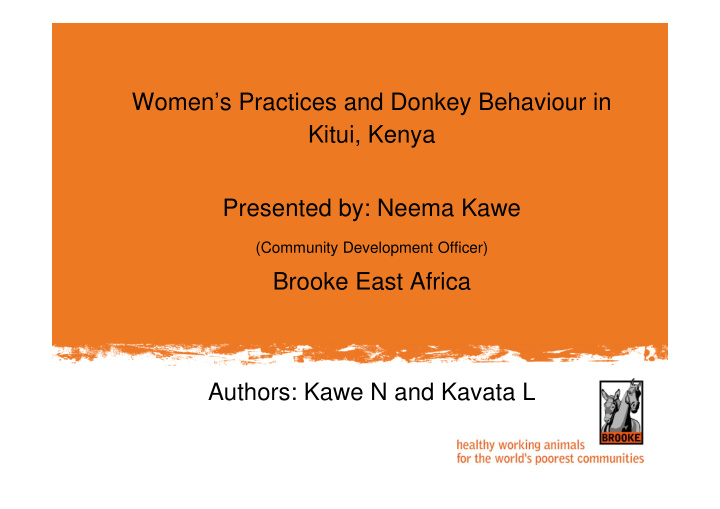



Women’s Practices and Donkey Behaviour in Kitui, Kenya Presented by: Neema Kawe (Community Development Officer) Brooke East Africa Authors: Kawe N and Kavata L
Brooke East Africa 2 The Brooke East Africa is a branch of the Brooke UK which is an international animal welfare charity committed to improving the lives of working horses, donkeys and mules in some of the world’s poorest communities. Initial processes in any given project site is the conducting appraisal of welfare situation of donkeys to and the knowledge, attitudes and practices of owners and users to identify and prioritize welfare issues to be targeted.
Brief Background 3 Kenya is located in East Africa bordered by Tanzania, Uganda, Ethiopia, South Sudan and Somalia. It comprises 47 counties and has a total national donkey population of 1.8 million.
4
Kitui County 5 • High donkey population (136,621 which is 8% of the 1.8 million donkey population in Kenya) • No other organization/government working to address donkey welfare issues in this region • A number of welfare issues had been identified that affected working donkeys in the area
Why women in Kitui? 6 Women represent a large proportion of donkey owners and users in Kitui County. 99.7% of the donkeys examined were pack animals used to aid in household chores i.e. ferry water and firewood; and carry light goods such as cereals and vegetables to and from the market. Women depend on these donkeys for their livelihoods.
Kitui County is in the South East part of the Country 7
8 A woman fetching water with her donkeys from a watering point - seasonal river
Objectives 9 • To examine the frequency of body lesions and negative behavioural indices in donkeys • Identify any potential contributing human practices that can be targeted for intervention
Methodology used 10 Brooke EA staff taken through a 2 week training on The Brooke’s SEBWAT approach that included field practical and a standardization process. 2 staff were required to work together on the same animal and reach a consensus on the score. A 2 day training on the HBI tool was conducted and a pre test done on the tool with the data collectors before actual data collection.
Animal Based Indicators (ABIs) 11 Animal Based Indicators were assessed using The Brooke’s Standard Equine Based Welfare Assessment Tool (SEBWAT).
ABI (Body lesions) 12 Severity Score 0 Lesion Severity Score 1 Lesion No Lesion A healed lesion. Photo show Skin clearly not broken both grey and pink hairless skin
13 Severity Score 2 Lesion Severity Score 3 Lesion skin and immediate lesions deep to show muscle, subcutaneous layers are tendon or bone broken
14 Behaviour/ Observer approach Score 0 – Alert but not afraid, calm but not apathetic Score 1 – apathetic, dull or non responsive Score 2- Nervous, frightened or aggressive
Human Based Indicators(HBIs) 15 Human based indicators were collected through structured questionnaires targeting donkey owners/users and direct observation of the donkeys while at work. Key aspects that were asked were on whether they kick/shout/whip their donkeys and an observation made on these practices Observation on the women harnessing practices
Sampling Approach 16 A total of 138 randomly sampled women were interviewed across Kitui County in 9 town centres that were purposively selected in August 2014 for a period of 5 days. 344 donkeys were assessed using random sampling at key watering points where a majority of the owners convene to collect water and at home for ease of access
Key Findings 17 % of donkeys that displayed the indicated Animal Based Indicators 60 50 40 30 20 % of donkeys that 10 displayed the 0 indicated Animal Based Indicators
Tail Base lesion 18
19 % of women owners displaying negative practices 80 70 60 50 40 30 % of women owners 20 displaying negative 10 practices 0
20
Discussion 21 • High prevalence of lesions maybe contributed to by inadequate knowledge of appropriate harnessing • High prevalence of fear/flight responses and apathy maybe contributed to by inadequate knowledge in handling skills that is compounded by negative attitudes towards their donkeys
Way forward 22 Through community engagement, the issues identified will be addressed through: - Knowledge gaps – training sessions with the women donkey owners will be conducted to pass on proper knowledge that will also include practical demonstration on how proper handling. Basic wound management for wound treatment and linkage to Local service providers.
Way forward…cont 23 Other approaches include the strengthening of social women groups as one of the avenues to reach out to a majority of women on Animal Welfare that advocate for peer to peer pressure that support the uptake of the best welfare. Reviewing of policy framework on animal welfare at the county level that would encourage owners to adopt the right welfare practices.
Way forward…cont 24 Support a community led monitoring system that will ensure the women are putting the new learnings on handling and harnessing practices into action for sustainability purposes.
25
Recommend
More recommend